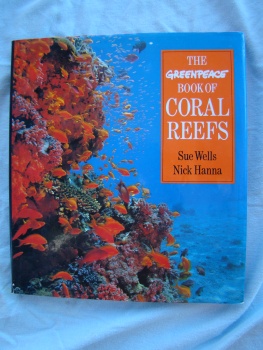
By Bob Goemans

TITLE: The Greenpeace Book of Coral Reefs
AUTHORS: Sue Wells/Nick Hanna
PUBLISHER: Sterling Publishing Co., Inc.
ISBN 0-8069-87952
PAGES: 160
PRICE: $35.00

If you have had the pleasure to read/own the authors other fine works, i.e., Fish and When I first looked at the title of the book, I had a notion that I would possibly find inside the book a skewed assessment of environmental damage to our coral reefs. ...How wrong I was! This has to be the most elegant assemblage of factual data, combined with numerous, absolutely stunning high quality color photographs of various fish/invertebrate, and far away places pertaining to this subject matter that I have ever seen! The authors are to be commended for their well structured approach in bringing to the reader the importance of conservation when it comes to these delicate areas of our world. This is a book that the reef hobbyist will find hard to put down until every picture has been looked at, and every page has been read. Yet, it has nothing to do with aquariums, and/or the equipment/processes which keep our aquaria functioning. This book is all about just how extraordinary/complex natures reefs really are, and how overfishing, pollution, coastal development, intensive agriculture, natural disturbances, and global warming are impacting these delicate structures.
There are seven chapters. The first chapter, "The Life Of The Reef," contains various subsections devoted to: The Nature of Coral, Types of Coral, Coral Reproduction, The Growth of Reefs, Where Reefs Are Found, Parts of the Reef, The Turbulent History-Reefs of the Past, Types of Reef, and Inhabitants of the Reef. This chapter also has the best color photographs I have ever seen and is, in my opinion, alone worth the price of the book. Chapter Two is titled "People & Reefs." It's subsections discuss: Reefs in the Twentieth Century, Reef Research, Medicinal Uses of Reef Species, and also has some remarkable color photographs. Chapter Three is titled "Vulnerability & Resistance." It's subsections discuss: Hurricanes, Turning up the Heat: Coral Bleaching, Reefs and the Rising Seas, Coral Reefs and a Changing Climate, Crown-of-thorns Starfish, Other Reef Predators, Coral Diseases, Upsetting the Balance, and Ciguatera, which is a common fish poisoning in the tropics. Chapter Four, "Development & Pollution, Halting the Destruction," has many subsections of which some are: Silting up the Reefs, Coral Mining, Sewage and Fertilizers-Pollution from Nutrients, Oil Pollution, Damage from Shipping, Coastal Development, and Preventing Reef Destruction. Harvesting The Reefs, Chapter Five, looks at Traditional Fisheries, Dynamite Fishing and 'Muro-Ami,' Mariculture, Artificial Reefs, Controlling the Harvest, The Aquarium Trade, Farming and Restocking Depleted Reefs, and Regulating Trade to name but some of it's subsections. Chapter Six, "Reefs & Tourism" and Chapter Seven, "Hope For The Future" also have many, very relevant subsections. The book closes with a special section dedicated to "How You Can Help," which leans towards what divers/snorkellers and boat users can do to protect these precious habitats.
One of the reasons I have taken the time/space to note most of the subsections, is so that you can see the diversity of subject matter. What also really impressed me is the fair and honest assessment of these threatened habitats. If you love this hobby as much as I do, then "The Greenpeace Book of Coral Reefs" belongs on your library shelf!